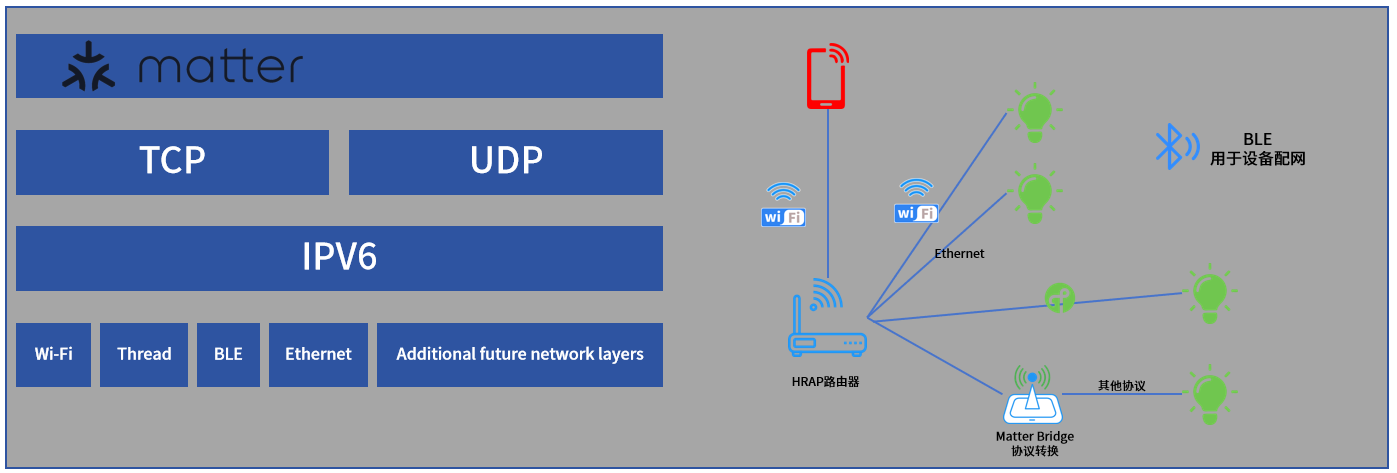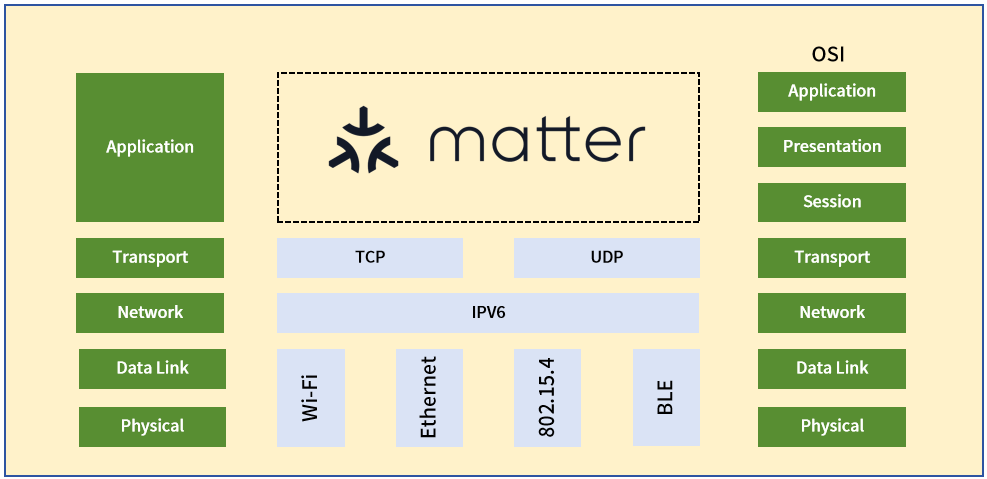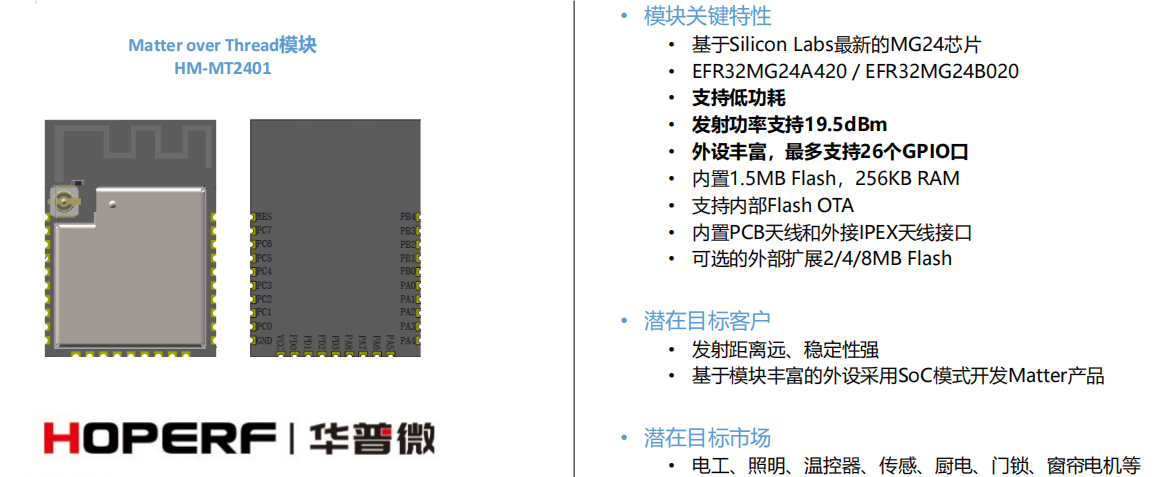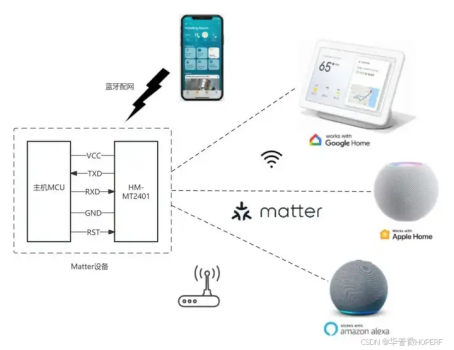HOT Search
Hot News
Matter is an open-source interoperability standard developed by Amazon, Apple, Google and other international ecological giants together with CSA Alliance (formerly Zigbee Alliance) for the smart home industry, which allows smart home devices of different categories and brands running under different communication protocols to communicate and control each other in the same home environment, and is the mainstream solution for eliminating problems such as fragmented experience and fragmented communication protocols for multi-device collaboration in the smart home industry at this stage. It is the mainstream solution to eliminate the problems of fragmentation and communication protocols in the smart home industry at this stage.

Matter standard protocol stack and network topology diagram
As shown in the figure above, Matter standard is an application layer protocol, which does not define new communication protocols, but reuses the mature TCP/IP protocol family (TCP/UDP is the transport layer protocol, IPv6 is the network layer foundation), so smart home devices adopting the Matter standard only need to follow the unified application layer specification, which is compatible with Wi-Fi, Thread, BLE, Ethernet and other IP-based protocols, BLE and Ethernet and other IP-based communication protocols.
Previously, due to the different operation logic of different communication protocols, it is often difficult for smart home devices using different communication protocols to communicate with each other, just like the difficulty of communicating with people of different languages, while the Matter standard specifies a unified data model and interaction model on the application layer, which is equivalent to providing a set of mandatory universal syntax rules for smart home devices, and can realize seamless interaction between devices. Seamless interaction between devices.
As shown in the figure below, comparing with the industry standard OSI (Open System Interconnect) reference model, the application layer defined in the Matter standard corresponds to the highest layer of OSI (layer 5~7), which is mainly used for communication and instruction transfer between devices, and can directly provide network services for users, and its functions include application program selection and invocation, and data transfer. Its functions include application program selection and invocation, as well as data processing and exchange.

Comparison of the Matter stack with the standard OSI model
The specific role of the application layer is to define "what" the devices can do and "how" the devices collaborate with each other. For example, in a Matter network, when the temperature and humidity sensor using the Thread communication protocol detects that the humidity indicator in the home environment exceeds the normal threshold set by the homeowner, it can be used as the basis for the application layer. For example, in a Matter network, when the temperature and humidity sensor using the Thread communication protocol detects that the humidity index in the home environment exceeds the normal threshold set by the householder, it will automatically send the "power on" command to the dehumidifier using the Wi-Fi communication protocol, and the "power on" command and its response will be accomplished through the application layer, which is a process that does not require the user's intervention, but is also a part of the application layer. This process does not require user intervention at all, but it is also the application layer that plays a role.
It is worth mentioning that the application layer specification defined by the Matter standard is not only applicable to the linkage between devices, but also to the control of devices by the householder. For example, the logic of the above temperature and humidity sensor triggering the "power on" command of the dehumidifier and the householder giving the "power on" command to the dehumidifier through the smart home ecological APP is exactly the same as the logic of the "power on" command of the dehumidifier. For example, the logic of the above temperature and humidity sensor triggering the dehumidifier's "power on" command and the householder giving the "power on" command to the dehumidifier through the smart home eco-app are completely consistent - and this is the core of the Matter standard that can realize cross-scene collaboration.
By adopting the Matter standard, smart home devices will be able to seamlessly integrate into all major home ecosystems and share the future trillion-dollar blue ocean market with all ecological giants. So, for smart home device manufacturers, how to enter the Matter industry and quickly develop Matter-compliant smart home devices?
The answer is obvious, as the key hardware unit to support the landing of Matter standard, choosing a mature and reliable Matter module that can be quickly integrated has become a common "weapon" for all smart home device manufacturers to quickly enter the Matter track.
For example, the HM-MT2401 independently developed by HOPERF is a Matter over Thread wireless communication module based on 2.4GHz frequency band, which has been widely used in LED lamps, smart switches, smart sockets, smart door locks, smart curtain motors, smart doorbells, smart thermostats, smart sensors and many other smart home devices.

The HM-MT2401 is equipped with a high-performance, highly integrated EFR32MG24 RF processor chip, embedded with a low-power 32-bit ARM® Cortex®-M33 processor core, equipped with 1536kB Flash and 256kB RAM, as well as a rich set of peripheral interfaces.
For smart home device manufacturers, engineers only need to integrate the HM-MT2401 into smart home terminal devices through simple interface design, which can upgrade the original terminal devices to Matter devices compliant with the Matter specification, which not only greatly reduces the difficulty of Matter product development, shortens the development cycle, but also accelerates the speed of Matter products to market. speed of Matter products to market.

Application diagram of HM-MT2401 module
For consumers, after choosing their favorite device from any brand that supports the Matter standard, they only need to open the smart home app on their smart phones (such as Apple Home App), scan the QR code of the Matter device, and follow the intuitive and easy-to-understand guideline process, then they can complete the device's network allocation and network operation with the help of Bluetooth technology to realize the connection with Amazon, Alexa, Apple HomeKeys, Apple HomeKeys, Apple HomeKeys, and Apple HomeKeys. By scanning the QR code of the Matter device and following the intuitive guidance process, the device can be connected to the network through Bluetooth technology, realizing seamless interconnection with the world's mainstream smart home platforms, such as Amazon, Apple HomeKit, Google Home and Smart Things.